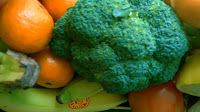According to a study
done in 2011 by the CDC’s National Center for Health Statistics, more than 50%
of adults take one or more dietary supplement. Americans spend billions of dollars a year on dietary
supplements, some of which is harmful, unnecessary, or taken incorrectly. This week we explore vitamins and why
we need to take them.
Dr. Priscilla Monroe,
Naturopathic Doctor, explains:
Why do we take vitamins?
I believe we take vitamins because we need extra nutrients
that we’re not getting in our food either because we’re not eating healthy or
because the food we eat now doesn’t have the same nutrients it used to. In the older days, we let our fields
flood so that the silt would come in and re-nourish the soil. Now what we have is levees that prevent
fields from flooding so our soil becomes depleted. Farmers do not get paid on the nutrient value of their crop,
they get paid by how much it weighs.
They add Nitrogen to their soil, which doesn’t contribute to nutrients
just helps increase its volume. We
ship our food in from all over the world. It’s not picked at its peak so that it can travel thousands
of miles. That’s why it’s
important to support our local farmers at farmers markets that sell in season,
fresh foods picked in the peak of their ripeness. Another factor is that we live in such a polluted world and
we are under a lot of stress, which demands more than we are able to get in our
daily intake of food. A lot of
people have trouble absorbing nutrients, so even if we eat enough, we still may
not be absorbing enough of it.
Stress suppresses our digestion and how many of us don’t function under
stress much of the time?
 More on Vitamins
More on Vitamins
Many people bring in a one-a-day vitamin and the thing that
I try to educate them on is that a one-a-day is like eating all of your food at
one time. You eat throughout
the day because your body can’t eat once and then use that food throughout the
day to nourish your body. A multiple vitamin is mixed; it has
fat-soluble vitamins: A, D, E, & K and water-soluble vitamins; the Vitamin B
and Vitamin C. Vitamins A, D, E,
& K can be taken at one time because the body utilizes what it needs at
that time and puts in storage what it doesn’t need. Later in the day as the body needs those vitamins, it will
pull it out of storage. But a
water-soluble vitamin like Vitamin B and C, which are stress vitamins, the body
utilizes what it needs at that moment and then it pees out the excess. So now later in the day as you’re more
stressed, you don’t have the reserves stored in your body to handle that.
Think about taking a pain medicine: Do you normally take the recommended
dose of pain medicine? People
taking a one-a-day vitamin is equivalent to taking a suboptimal therapeutic
dose of pain medicine. For
example, if you were taking Ibuprofen for a headache, the recommended dose is 200
mg every 4-6 hours. Would you be
inclined to take half that dose once a day in order to relieve your headache? Most people wouldn’t. The pain doesn’t go away. The same goes for vitamins and their
doses.
Does a typical multivitamin have a balanced ratio of water-soluble and
fat-soluble?
No, most one-a-days are very low potency, they’re really not
so good. The professional line
that I carry is very high potency. I don’t worry about any of them being too
much. Some of them are 1,000 times
the RDA. But, since they are capsules, doses can be modified by how many you
take.
What’s RDA? Is 1,000 times
the RDA good or bad?
When people worry about a vitamin exceeding RDA (Recommended
Daily Allowance), the RDA is the minimum required to prevent a disease. For instance, Vitamin C RDA is 60
mg. That’s the minimum that’s
required to prevent scurvy. Now, I
don’t know about you, but I don’t just want to prevent scurvy, I want to
optimize my health. So when vitamins
have a couple hundred times more than what the RDA is and it’s a water-soluble,
often times you don’t have to be worried about it. Fat soluble vitamins you want to watch much more than the
water-soluble ones. When I get
people with over the counter one-a-days, many of them have talc in it. Almost all of the ingredients are synthetic.
DL Alpha (or the alpha symbol) on the label let’s you know that it’s synthetic.
Give me an example of other additives or things to look for?
Well most of them have Calcium Carbonate as opposed to a
Calcium Citrate or Calcium Citrate Malate. Calcium Carbonate is hard on the gut, you have to take it
with meals or you increase your risks of kidney stones, and it’s not well
absorbed. It has a solubility of
.14 as opposed to Calcium Citrate that is 7 or 8 and Calcium Citrate Malate,
which is 80. So, it is poorly
absorbed, low quality Calcium.
So many vitamins have Iron in them as well. Often times we need to be cautious about
that. When we impose Iron on a body
that is not anemic, we increase the risks of free-radical damage, which is a
precursor to cancer. Young
menstruating women might be able to get by with it, but menopausal women
(because they don’t lose blood monthly) it’s even more dangerous for. It can be potentially problematic even
in young women who eat red meat, spinach, and other foods high in Iron.
Philosophically, I like a capsule better than a tablet. In a tablet, producers of vitamins must
add agents to make it stay together.
Often the tablet is so hard the body cannot absorb the vitamins and it
never dissolves, exiting the body as it came in.
------------------------------------------------------------------------------------------------------------
If you live in Sacramento or elsewhere and are interested in
ordering high quality supplements, please contact me. I ship nationwide and can help you find a dosage that’s
right for you.
I’m happy to answer any questions and am scheduling new
patients. Please contact me for
more information or go to my website:
www.drpriscillamonroe.com
to see if a Naturopathic Doctor is right for you.
Dr. Priscilla Monroe,
RN, ND.
Sacramento, CA
916-448-9927
------------------------------------------------------------------------------------------------------------
Thanks for reading this week! Send your questions to drmomnaturopath(at)gmail.com
for the blog or directly to Dr. Monroe at drpjmonroe(at)gmail.com. We look forward to sharing another
topic with you next week!
Have a wonderful weekend, visit a local farmer’s market
& stay healthy!
--Briana
 The holidays are upon us again and we need not be reminded that it also
poses many a temptation to compromise our health: the goodies, drinking, late
nights and stress.
The holidays are upon us again and we need not be reminded that it also
poses many a temptation to compromise our health: the goodies, drinking, late
nights and stress.













